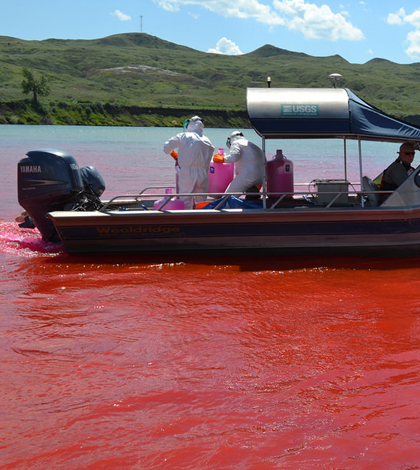Low Recruitment Of Pallid Sturgeon Baffles Missouri River Researchers

U.S. Geological Survey scientists add rhodamine dye to the Missouri River to aid in a study of pallid sturgeon larvae transport. (Credit: U.S. Geological Survey)
Along the Missouri River, researchers with the U.S. Geological Survey (USGS) have used a dye typically used to study the flows of contaminants in an effort to help endangered pallid sturgeon. Results of their efforts may clear up questions on the fish’s poor recruitment rates in the waterway.
It’s estimated that there are currently only 100 to 125 pallid sturgeon in the Upper Missouri River and its Yellowstone River tributary. In the mid 1960s, following their last successful recruitment, there were around 1,000.
“It’s unknown why they’re not recruiting,” said Susannah Erwin, research hydrologist with the USGS’ Columbia Environmental Research Center. “They are very rare fish and reside in the bottom of a large turbid river, ‘the big muddy,’ so we have a poor understanding of what factors are limiting recruitment.”
To get a better idea of the dynamics at play, Erwin and a team of scientists from the agency recently sampled down a stretch of the river between the Fort Pack Dam, managed by the U.S. Army Corps of Engineers (USACE), and upstream from Lake Sakakawea. They used 13 gallons of rhodamine dye to color the river a bright red and tracked its movement downstream, as the color dissipated, with a network of fluorometers placed along shore.
The idea was to study dye movement and dispersion as a proxy for sturgeon larval transport.
“We were trying to better understand the dynamics of drifting larvae,” said Erwin of the fieldwork effort that lasted from June to July 2016. “When they’ve just hatched … they’re relying on a yolk sac for sustenance and eventually develop into an organism that is feeding and eating invertebrates. We’re concerned that there may not be adequate drift distance available to make that development possible.”

Susannah Erwin retrieves fluorometers from the Upper Missouri River to download dye trace data. (Credit: U.S. Geological Survey)
There isn’t a set distance that the larvae need to transition, she says. More important are the flow rate of the section under study and the water temperature. If the waters are moving too fast, or are too warm, then the young sturgeon may just not have the time they need to mature.
Alongside the dye-tracking effort, a separate team of USGS researchers worked to complete an experiment charting the movements of actual sturgeon larvae. They released larvae and fished them out of the river using nets over 10 days and nights.
“In all, they released more than 700,000 pallid sturgeon larvae into the river,” said Erwin. “So we’ll be able to compare results with a passive tracer (the dye) and the actual biological organisms.”
Both of the efforts were part of the Missouri River Recovery Program science effort. Erwin and others are now busy sifting through all the data they’ve collected.
Hopes after that are to plug the data into models that the USACE already have on particle transport in the river to make them more accurate. Results so far are looking good.
“From an early analysis, what we can see is that the advection-dispersion model performs reasonably well, surprisingly well in terms of matching travel times, matching the dye trace,” said Erwin. “The data will allow us to further refine it from there.”
Several other institutions helped in the work in addition to the USACE, which controlled flows from the dam during sampling. The U.S. Fish and Wildlife Service and the State of Montana were also involved as well as the U.S. Bureau of Reclamation, Western Power Administration and Nebraska Game and Parks.
Findings from the work will help to inform the Missouri River Recovery Program, an effort to avoid jeopardy for three threatened species along the river: pallid sturgeon, least tern and piping plover.
Top image: U.S. Geological Survey scientists add rhodamine dye to the Missouri River to aid in a study of pallid sturgeon larvae transport. (Credit: U.S. Geological Survey)
—
CORRECTION: A version of this story appearing in our Fall 2016 print magazine incorrectly quoted Susannah Erwin. Those quotes have been updated in the online version of the story along with other errors. Specifically:
-A quote in the third paragraph of the print version has been updated to “They are very rare fish and reside in the bottom of a large turbid river, ‘the big muddy,’ so we have a poor understanding of what factors are limiting recruitment.”
-A quote in the 12th paragraph of the print version has been updated to “From an early analysis, what we can see is that the advection-dispersion model performs reasonably well, surprisingly well in terms of matching travel times, matching the dye trace.”
-A portion of paragraph seven has been updated to: More important are the flow rate of the section under study and the water temperature. If the waters are moving too fast, or are too warm, then the young sturgeon may just not have the time they need to mature.
-An update to paragraph four notes that 13 gallons of rhodamine dye were used.
-An update to paragraph eight notes that the investigation took 10 days and nights.
-An update to paragraph 10 notes that efforts were part of the Missouri River Recovery Program.
-An update to paragraph 13 notes that Nebraska Game and Parks also assisted in the work.
-An update to paragraph 14 notes that the Missouri River Recovery Program is an effort to avoid jeopardy for three threatened species.




0 comments